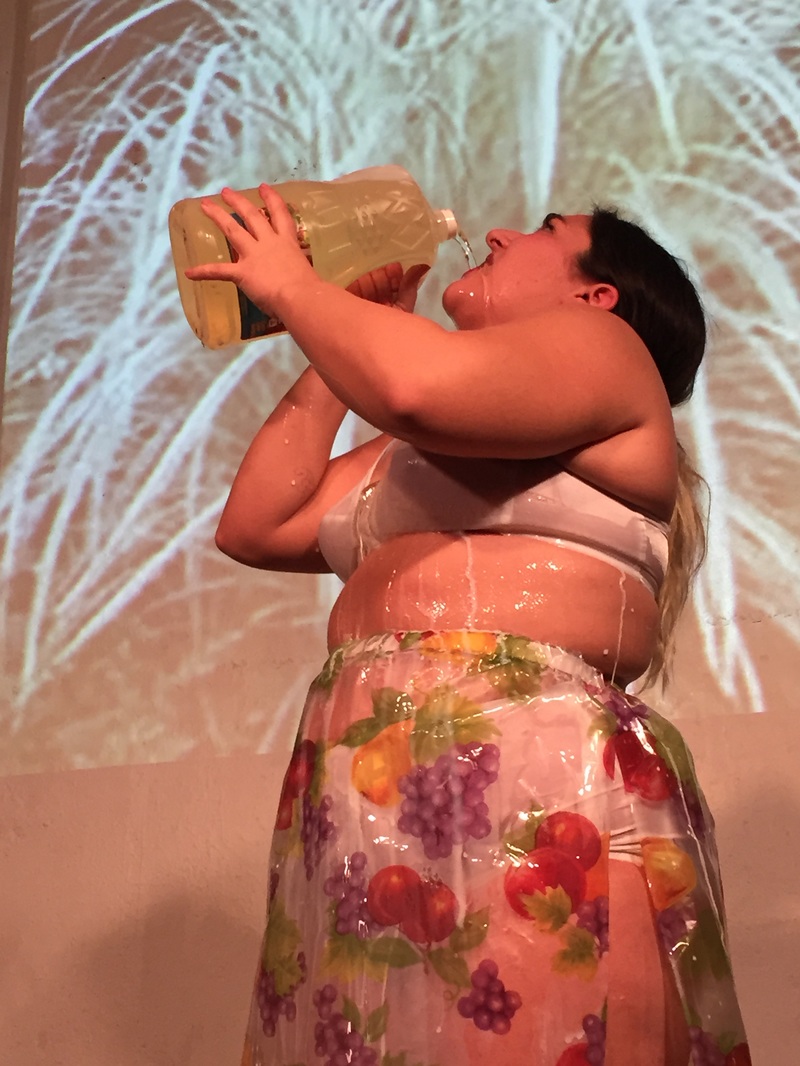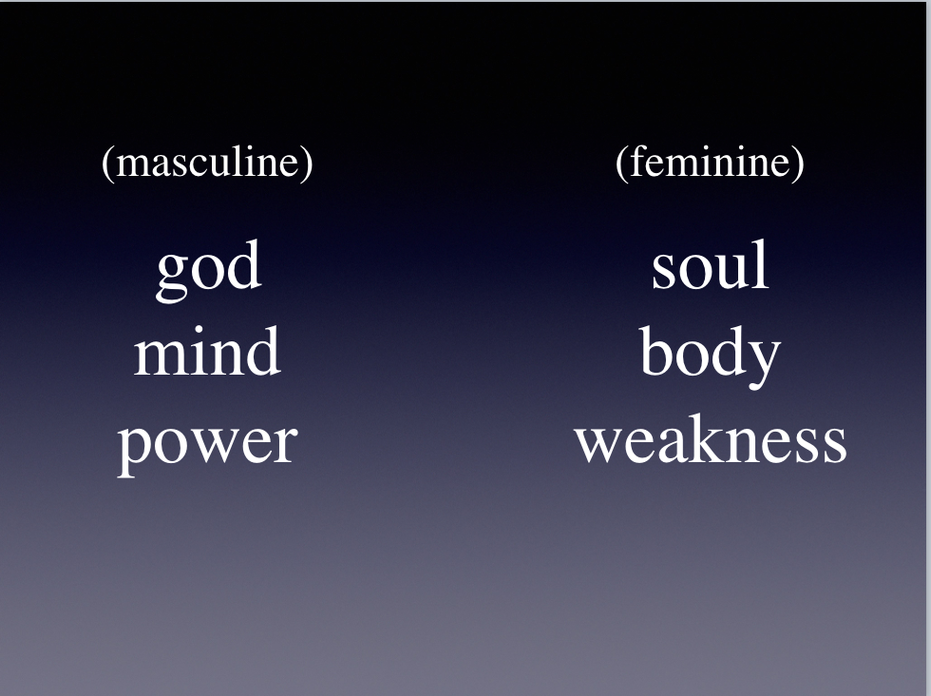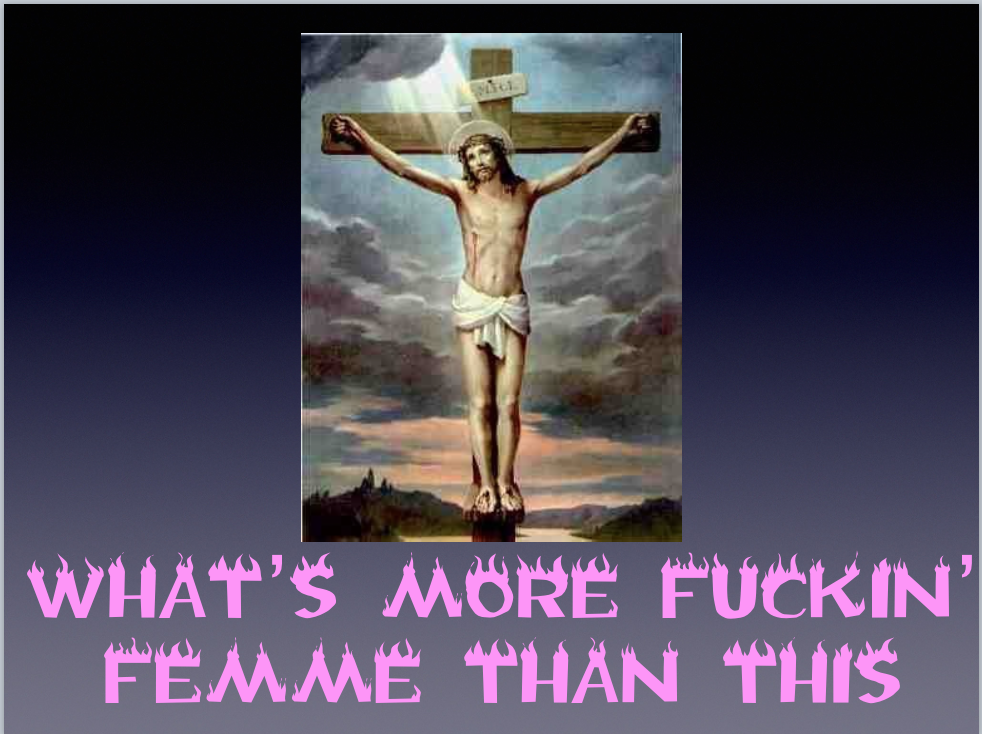|
Last month I witnessed an evening of performance at Panoply Performance Lab in Bushwick, Brooklyn. Performancy Forum featured local artists: Huisi He, David Ian Griess, Sara Debevec, Jon Konkol and Emily Oliveira. Debevec embodied an anthropomorphized insect self. Griess looped home video in dedication to his grandmother. Konkol threw up condiments while yelling in German at his latex-blob children. He tiptoed barefoot thru active mousetraps while reciting self-affirmations on “making it“ in NYC. Lastly, Oliveira presented a complex, 3-part performance exploring female archetypes within Catholic doctrine. Following Emily Oliveira’s performance, I spoke with fellow audience member and feminist artist powerhouse, Katya Grokhovsky about Oliveira’s piece. We mutually agreed on its success. The following day, a VERY heated online Facebook discussion began between several audience members about Oliveira’s work. Albeit somewhat difficult for me to negate individual names here - I have decided that since the online post/conversation was initiated with some anonymity (and has thus since been deleted) – I will keep individual names out of this post. But I will say, that the dissatisfaction and frustration toward Oliveira’s work stemmed mostly from male audience members. Several prominent performance art leaders within the Brooklyn community were polarized on the work. I thought to myself, WHOA! – I can’t believe I am reading such drastically different critiques on a work that I deemed so successful! Oliveira’s performance hit several nerves. So much so that a divide grew between Brooklyn’s intimate performance art community. Which, in my mind, really means something. Yes, critical dialog in performance art is much needed and the only thing missing in this discussion was the perspective of the artist. So... I reached out to Oliveira and offered an opportunity for her to discuss her intentions and respond to the FB critique. Since Performance Is Alive is devoted to sharing the words of the artist - I am delighted to share Emily Oliveira’s voice with you here. - QUINN DUKES Quinn Dukes: What is the title of the work presented at Panoply Performance Lab on February 18th? Emily Oliveira: Woman's Day (who baked the bread for the last supper) QD: What led you to create feminist based performance work? EO: I don't really know if there is any way for me to make performances that aren't feminist or from a feminist perspective, so I don't think it's a choice as much as the only way I know how to make work. Even if someone, I don't know, commissioned me to make a performance ($$yes please$$) about how pencils are manufactured, there would still be this loud, big-assed, brown, femme body prancing around on stage. But even work that doesn't include my own body (my sculptures, installations, costumes) feels impossible to detach from my lived experience as a woman. To divorce myself and my work from that experience sort of feels like pulling my own teeth out. I could do it, but it would be pretty excruciating, and what the hell is the point anyway? QD: Why the power point approach? EO: This is the first time I've ever used power point or a presentation in a performance. I chose it because I wanted to have a casual conversation with the audience and introduce a lot of information very quickly, aided by visuals. I also wanted the presentation to sort of feel something like a Mary Kay recruitment seminar, presenting this rubric of female suffering: being a "body" (marriage, sex, children), being a "brain" (hermeticism), and then offering the miraculous, spiritually significant suffering of Virgin Martyrdom as a third option. QD: You can sing! Can you address the song you chose to sing? Why? EO: Thank you! I love music and I use it in all of performances. I chose the song because, much like the stories of Virgin Martyrs, 'Stand by Your Man' has been co-opted to disempower women, when its relationship to empowerment is so much more complicated. Tammy Wynette was this powerful, funny, immensely talented, firecracker of a woman who suffered tremendously at the hands of men her entire life. And then we stand here and asset that "Stand By Your Man" is this anthem of obedience and acquiescence?? 'Stand By Your Man' is a feminist war cry wrapped in rhinestones and pink satin. It sets up this neat diorama of the power imbalance inherent in heterosexual relationships (with a little dash of cheating and abuse!) leaves its audience right where they started: smack in the middle of that awful relationship, crossing our arms and standing by the men who hurt us. Because that's where we are. Feminist narratives that feature women gleefully escaping the swiftly approaching train of the patriarchy are great! But they often leave me saying "Ok, but what about the rest of us? We're still tied to the tracks." QD: Why guzzle oil, milk and beet juice (blood, idk what it was)? EO: It was fake blood! These three materials were there to represent different bodily fluids: cow's milk for breast milk, stage blood for real blood, canola oil for bodily oils but also chrism. Almost every single virgin martyr legend includes imagery of miraculous, holy bodily oozings and excretions: a severed neck oozing both blood and holy oil (chrism), virgin breasts miraculously lactating, breast milk or holy chrism coming out of wounds, etc. etc. This is also coupled with the widely held medieval belief that the bodies of holy women do not menstruate or sweat. The body of Christ oozes his holy blood, which we, in turn, drink and receive eternal life, making our relationship with the blood of Christ closer to our relationship with breast milk, and the wounds of Christ closer to the breasts of a lactating mother. I wanted to (erotically and painfully) reverse the path of these fluids, like rewinding your high school's VHS of 'The Miracle of Life' and watching the baby go back in. QD: How did you feel post performance? EO: I felt good post-performance! A little shaken up because it was kind of emotionally draining for me, the ending definitely had me feeling sort of faint and vulnerable, but happy that I was able to share this thing with a bunch of people. QD: Can you respond to the online FB discussion posed about Woman's Day (who baked the bread for the last supper)? (Please note that Emily’s response has not been edited). EO: I definitely feel like the "not-my-intention" conclusions that he drew were 50% my fault for not being clear enough (because he was definitely not the only person to take away these conclusions from the performance! A thing I am really glad that I know now!) which I take 100% responsibility for, of course. The other 50% is that I feel like he brought an immediate assumption of intellectual superiority to his reading of the piece. So if you are entering into a performance with an immediate "I am so much smarter than this girl, there's no way she's read all the books I have", then how on earth can you even listen to what I'm saying? The perception that I am not smart (mostly because I am a woman, ultra-femme, kinda young, an artist, big-ass-having, half latina, and because a lot of my performance personae/me as an actual person is a very femme, flippant, and catty) is something that I think I have grown sort of blind to, but that I'm glad that his post has made me more aware of it? Am I going to change my work to perform whatever version of intelligent bitch will satisfy men enough so that they don't think that I'm a big dumbass who hasn't read all of the books they have? Not on your life. But I do know now that I have to be clearer about exactly what I mean in order to overcome the immediate assumption that I am stupid. So the fact that he believes that the thesis of my performance was that Virgin Martyrs are/were these helpless victims and that my examination of these narratives was in this very Feminism 101 (Isn't This a Terrible Thing That We Can All Agree Is Terrible) was pretty shocking to me. Mostly because that is the exact opposite of how I feel, and because there were several slides and lines in the show that directly contradict that. Lucy plucking out her eyes or Rose rubbing her face with lye are the most empowering things in the world to me. The idea of a woman trading "traditional" modes of female suffering (being a body: marriage, sex, childbirth, motherhood, old age, or alternately the loneliness of hermeticism/being a "brain") for the cosmic suffering and ecstasy or martyrdom is so goddamn exciting and empowering to me. However, I do think that it is wildly irresponsible to just stamp all of these stories with a big, red "This Is Empowering" stamp just because I find them empowering. It is more than worth examining the fact that these narratives have been almost exclusively controlled/written by men, ostensibly to inspire both men and women spiritually, but not-so-secretly to also "inspire" men erotically. These stories are intensely, violently erotic and not in a way that is "for" or controlled by the martyrs themselves. They are erotic in a way that trivializes the courage and agency of these women, and that reminds us that even political, artistic, intellectual, and spiritual acts by women will be eroticized by men in order to undermine their power. This is something that one must constantly confront as a performance artist who identifies as a woman. That getting up in front of people and presenting your voice and your body and taking up space and having opinions is scary for cis men, and that the natural reaction to that assertion of your agency is eroticize you and to mentally place you into the categories of "Would Fuck" or "Gross, Would Not Fuck" in order to escape their fear/discomfort and undermine your power. Which is why my performance ended with the reverse-erotic-vomiting/deep-throating gallons of blood and milk and oil. I wanted to erotically suffer, but in a way that I had chosen and had complete physical control over. The goop-chugging was meant to both punish and empower me, and to make the audience confront their simultaneous hunger for female suffering, their discomfort with suffering that the woman has agency in, and their conscious or unconscious eroticizing of my body. To respond to another aspect of his post: I have and would never satirize religion. Religion is incredibly important to me, and Catholicism is at the core of everything that I do; in my everyday life but especially in my art practice. As modern women, we do not have the power to make our suffering cosmically significant except through performance. For modern women, fasting or other ascetic acts are exclusively connected with narcissism or bodily punishment (hence the text in my performance from the magazine For Women First) rather than the assertion of fleshliness and drawing oneself closer to the human-ness (and femme-ness) of Jesus and his suffering. I feel that virgin martyr legends are more relevant to discussions of the passion and crucifixion of Jesus than the martyrdom of male saints, but that the "femme" ness of Jesus and of Catholicism gets sort of swept under the rug. It's also interesting to me that my referring to Jesus's passion and crucifixion as 'femme' was read as satirizing religion? Could it be that he views femme-ness as somehow insulting or less-than? IF THEN As a final note, I really enjoyed him calling my work "vain", "self-indulgent", "lazy", and "tawdry". These are all things I love to be. These are things that are performatively exciting to me. Especially because the opposite of these things would be work that is modest, austere, virtuosic, sober, and earnest, which is a style of performance that I feel puts a hyper-masculine, capitalist emphasis on virtuosity and authenticity (gag). Femme-ness has a delightfully murky relationship with authenticity. Femininity is viewed as inherently deceptive, with the power to use that deception to destroy/dismantle masculinity. Because it is so difficult for men (esp. white, cis/het men) to ever wrap their minds around the idea of living every day with a fluid, performative relationship with their perceived/actual identity, the immediate reaction is to label feminine art as trivial or inauthentic, as if the whole point of thing isn't to snap that **authenticity yardstick** over my thick ass thigh.
0 Comments
Leave a Reply. |
CONTRIBUTORSIan Deleón Archives
July 2023
|
|
MISSION // Based in Brooklyn, NYC, PERFORMANCE IS ALIVE is an online platform featuring the work and words of current performance art practitioners. Through interviews, reviews, artists features, sponsorship and curatorial projects, we aim to support the performance community while offering an access point to the performance curious.
Performance Is Alive is a fiscally sponsored project of Fractured Atlas, a 501(c)(3) charity. Contributions made payable to Fractured Atlas for the purposes of Performance Is Alive are tax-deductible to the extent permitted by law. |




